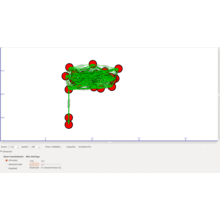Category Archive: 'M.Tech Projects in NS3'
Cloud and enterprise application integration (CEAI) is a new challenge as more enterprise applications migrate successfully to cloud environments. However, achieving CEAI properties such as multitenancy, cloud-level scalability, and environmental heterogeneity is nontrivial for enterprise applications originally built under the assumption of centralized management. A concrete implementation of the cloud service bus approach, called JTangCSB, addresses the […]
Content downloading from vehicles is becoming increasingly popular, but it also meets challenges dueto the limited number of road-side units (RSUs) and the expensive cost of 3G/LTE downloads. Cooperative LTE + vehicle-to-vehicle (V2V) downloading schemes can significantly improve the efficiency and reduce costs. However, selfish users are motivated to minimize their own LTE downloading costs, so they would […]
Directional and pairwise measurements are often used to model interactions in a social network setting. The mixed-membership stochastic blockmodel (MMSB) was a seminal work in this area, and its ability has been extended. However, models such as MMSB face particular challenges in modeling dynamicnetworks, for example, with the unknown number of communities. Accordingly, this paper proposes adynamic infinite mixed-membership stochastic blockmodel, […]
Internet routing scalability issue is one of challenges of future Internet architecture. The global routing table is inflating with the growing number of networks connected to the Internet and the more-specific prefixes from multi-homing and traffic engineering operation requirements. Many engineering solutions have been proposed. In this paper, we propose a scalable routing architecture in a long-term intention for […]
In recent years, with the improvement of the high speed communication infrastructure, P2P content distribution systems have been attracting more attention. In a P2P content distribution system, the lack of a central management server provides the system its robustness. However, it also leads to problems in content reliability and accessibility. We propose a secure content distribution system […]
Session Initiation Protocol is an IP based signaling protocol used for establishing, modifying and terminating sessions. During the signaling process, both the peers may initiate similar or controversial signaling messages resulting in Race / Glare conditions. SIP protocol handles glare conditions by transmitting the signaling messages after a random interval of time, within a specified time range. […]
Modeling and prediction of temporal sequences is central to many signal processing and machine learning applications. Prediction based on sequence history is typically performed using parametric models, such as fixed-order Markov chains ($n$-grams), approximations of high-order Markov processes, such as mixed-order Markov models or mixtures of lagged bigram models, or with other machine learning techniques. This paper […]
In current cyber age, almost all the services are being provided to users over the cloud. Many of these services need to be highly available. Since these services require databases, the databases themselves must be made highly available. Redundancy is the technique of doing this. For this purpose Remus and its adaptation RemusDB use complete virtual machine migration to a backup […]
This paper introduces a novel and efficient approach for user cooperation in wireless video multicast using randomized distributed space time codes (R-DSTC), in which the sender first transmits the source packets, and the sender and receivers that have received all source packets then generate and send the parity packets simultaneously using R-DSTC. As more parity […]
Recent advances in information technology bring significant changes to the nature of social interactions and information exchange. Physical face-to-face communications are slowly replaced by online virtual communities. Motivated by this phenomenon, this research investigates how voluntary community involvement and self-disclosure behavior impact a member’s peer-recognition and task performance within a virtual crowd sourcing competition community. We collected secondary […]

 Click Here to watch our latest output video using NS3 simulator
Click Here to watch our latest output video using NS3 simulator  Click Here to watch our latest projects screenshots using NS3 simulator
Click Here to watch our latest projects screenshots using NS3 simulator